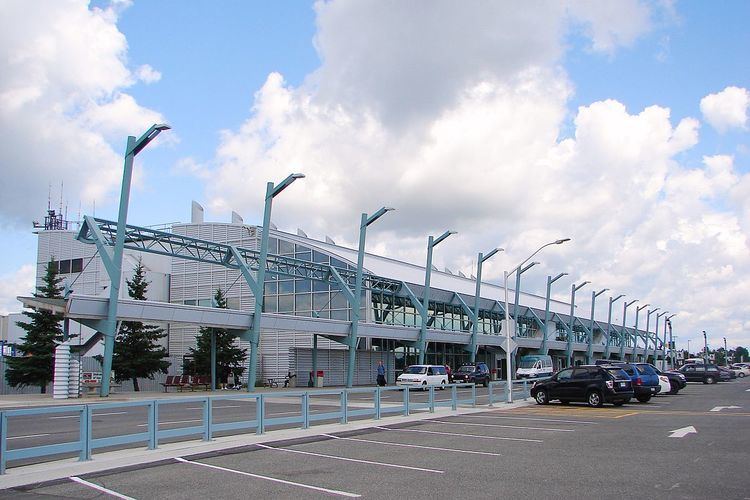Airport type Public Elevation AMSL 654 ft / 199 m 07/25 7,318 Elevation 199 m Province Ontario Serves Thunder Bay | Time zone EST (UTC−05:00) Website tbairport.on.ca Code YQT Phone +1 807-473-2600 Owner Transport Canada | |
 | ||
Operator Thunder Bay International Airports Authority Address 100 Princess St, Thunder Bay, ON P7E 6S2, Canada Profiles | ||
Landing at thunder bay international airport april 6th 2015
Thunder Bay Airport or Thunder Bay International Airport, (IATA: YQT, ICAO: CYQT), is an airport in the Canadian city of Thunder Bay, Ontario. With 108,130 aircraft movements in 2012, it was the fifth busiest airport in Ontario and the 16th busiest airport in Canada. During the same year, more than 761,000 passengers went through the airport.
Contents
- Landing at thunder bay international airport april 6th 2015
- Porter airlines inaugaural flight to thunder bay international airport
- History
- Historical airline jet service
- Tenants
- Parking and transportation
- Infrastructure
- References
The airport is classified as an airport of entry by Nav Canada and is staffed by the Canada Border Services Agency (CBSA). CBSA officers at this airport can handle aircraft with up to 40 passengers.
Porter airlines inaugaural flight to thunder bay international airport
History
It was built as the Fort William Municipal Airport in 1938, partly as a means of relieving unemployment.
During World War II, the Thunder Bay (then Fort William) airport was home to No. 2 Elementary Flying Training School, part of the British Commonwealth Air Training Plan. The airport was also used as a base for test flights of fighter aircraft being built at the nearby Canadian Car and Foundry factory.
Before the two cities of Fort William and Port Arthur merged, it was called the Canadian Lakehead Airport.
The airport went under major renovations in 1994 with the construction of a new airport terminal building, including two jetways, a large food court, a gift shop and an arcade.
The airport was handed over from the government in 1997 to the Thunder Bay International Airports Authority, a non-profit organization. The airport handled over 600,000 passengers in 2006 for the first time since 2001.
Historical airline jet service
A number of airlines served the airport with scheduled passenger jet service in the past from the late 1960s to the late 1990s. These air carriers along with the respective jetliner types they operated from the airfield are as follows:
According to various Official Airline Guide (OAG) editions, the majority of jet service operated by Canadian-based air carriers was nonstop or direct to Toronto and Winnipeg. U.S.-based North Central Airlines operated nonstop flights to Duluth with continuing no change of plane jet service to Chicago O'Hare Airport while successor Republic Airlines (1979-1986) also flew nonstop to Duluth with continuing no change of plane jet service to Minneapolis/St. Paul and then on to Denver.
During the mid 1980s, three airlines were competing with nonstop service operated with mainline jet aircraft between Thunder Bay and Toronto: Air Canada with Boeing 727-200 and McDonnell Douglas DC-9-30 aircraft, Nordair with Boeing 737-200 aircraft and Pacific Western Airlines with Boeing 737-200 aircraft.
Tenants
Parking and transportation
Vehicles can reach the airport via Ontario Highway 61 and connections with Harbour Expressway and Ontario Highway 11 into Thunder Bay's core.
The parking lot contains 100 short-term spaces, 300 long-term spaces, curbside taxi service and courtesy cars. Thunder Bay Transit bus route #3 Airport serves the airport terminal and the nearby Aviation Centre of Excellence.
Infrastructure
The Thunder Bay International Airport has a 2-storey terminal building.
Thunder Bay's runways are at present primarily being used by small or larger turboprop aircraft; however, they are capable of accommodating narrow-body jetliners such as current generation Boeing 737 aircraft operated by Air Transat, Sunwing Airlines and WestJet. As noted above, the airport routinely handled Boeing 727-200, Boeing 737-200 and McDonnell Douglas DC-9-30 mainline jet aircraft as well as the smaller Fokker F28 Fellowship twin jet in the past. Other larger jet aircraft types have also landed at the airport in the past with examples including a Boeing 720 operated by American Airlines in 1962, Boeing 757-200 and wide body Airbus A310 aircraft operated by Royal Aviation subsidiary Royal Airlines in 1999 and 2000, and a wide body Boeing 747SP operated as the "Global Peace Ambassadors" aircraft for Christian preacher K.A. Paul in 2005.
The airport also has two fixed-base operators: MaintAir Aviation Services Ltd. for Shell Aviation, and Thunder Bay Flight Refuelling for Esso Avitat.
